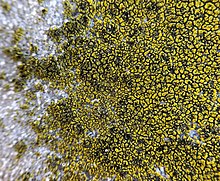| Flavoplaca | |
|---|---|

| |
| Flavoplaca flavocitrina | |
| Scientific classification | |
| Domain: | Eukaryota |
| Kingdom: | Fungi |
| Division: | Ascomycota |
| Class: | Lecanoromycetes |
| Order: | Teloschistales |
| Family: | Teloschistaceae |
| Genus: | Flavoplaca Arup, Søchting & Frödén (2013) |
| Type species | |
| Flavoplaca citrina (Hoffm.) Arup, Frödén & Søchting (2013) | |
Flavoplaca is a genus of crust-like or scaly lichens in the family Teloschistaceae. It has 28 species with a mostly Northern Hemisphere distribution.
Taxonomy
The genus was circumscribed in 2013 by Ulf Arup, Patrik Frödén and Ulrik Søchting, with Flavoplaca citrina as the type species. The genus formed a well-supported clade in molecular phylogenetic analysis. Flavoplaca species are closely related to Calogaya species that have lobes. There are other genera with roughly similar morphological features as Flavoplaca (examples include Polycauliona, Orientophila, Sirenophila, and Villophora), but they are genetically different and have different distributions. Arup and colleagues included 26 species in the genus; most were originally named as members of the genera Caloplaca or Lecanora.
Description
Flavoplaca species have a thallus that is either crust-like (crustose) or scaly (squamulose), sometimes with indistinct edges, and sometimes with lobes. They often have apothecia, and these are zeorine, meaning that the proper exciple (the ring-shaped layer surrounding the hymenium) is enclosed in the thalline exciple. Pycnidia can be present or absent; the conidia have a bacilliform to ellipsoid shape.
Four Flavoplaca species are lichenicolous; that is, they grow on other lichens. These are F. coronata (on saxicolous lichens), F. microthallina (on saxicolous lichens, commonly Hydropunctaria maura), F. oasis (on saxicolous lichens, particularly Bagliettoa calciseda), and F. polycarpa (on Bagliettoa). Only F. polycarpa has a truly lichenicolous mode of life; the others are facultatively lichenicolous, i.e., commonly collected from lichens but also known to grow on non-lichen substrates.
Species
Most Flavoplaca species occur in the Northern Hemisphere, and many are found in Europe. As of December 2024, Species Fungorum accepts 28 species of Flavoplaca:

- Flavoplaca arcis (Poelt & Vězda) Arup, Frödén & Søchting (2013)
- Flavoplaca arcisproxima (Vondrák, Říha, Arup & Søchting) Arup, Søchting & Frödén (2013)
- Flavoplaca austrocitrina (Vondrák, Říha, Arup & Søchting) Arup, Søchting & Frödén (2013)
- Flavoplaca calcitrapa (Nav.-Ros., Gaya & Cl.Roux) Arup, Frödén & Søchting (2013)
- Flavoplaca citrina (Hoffm.) Arup, Frödén & Søchting (2013)
- Flavoplaca communis (Vondrák, Říha, Arup & Søchting) Arup, Søchting & Frödén (2013)
- Flavoplaca confusa (Vondrák, Říha, Arup & Søchting) Arup, Søchting & Frödén (2013)
- Flavoplaca coronata (Kremp. ex Körb.) Arup, Frödén & Søchting (2013)
- Flavoplaca cranfieldii (S.Y.Kondr. & Kärnefelt) Arup, Frödén & Søchting (2013)
- Flavoplaca dichroa (Arup) Arup, Frödén & Søchting (2013)
- Flavoplaca flavocitrina (Nyl.) Arup, Frödén & Søchting (2013)
- Flavoplaca geleverjae (Khodos. & S.Y.Kondr.) Arup, Frödén & Søchting (2013)
- Flavoplaca granulosa (Müll.Arg.) Arup, Frödén & Søchting (2013)
- Flavoplaca havaasii (H.Magn.) Arup, Frödén & Søchting (2013)
- Flavoplaca kantvilasii (S.Y.Kondr. & Kärnefelt) Arup, Frödén & Søchting (2013)
- Flavoplaca laszloana S.Y.Kondr. & Hur (2017)
- Flavoplaca limonia (Nimis & Poelt) Arup, Frödén & Søchting (2013)
- Flavoplaca lutea (J.R.Laundon) S.Y.Kondr., Kärnefelt, Elix, A.Thell, Jung Kim, M.H.Jeong, N.N.Yu, A.S. Kondr. & Hur (2014)
- Flavoplaca marina (Wedd.) Arup, Frödén & Søchting (2013)
- Flavoplaca maritima (B.de Lesd.) Arup, Frödén & Søchting (2013)
- Flavoplaca mereschkowskiana (S.Y.Kondr. & Kärnefelt) Arup, Frödén & Søchting (2013)
- Flavoplaca microthallina (Wedd.) Arup, Frödén & Søchting (2013)
- Flavoplaca navasiana (Nav.-Ros. & Cl.Roux) Arup, Søchting & Frödén (2013)
- Flavoplaca nigromarina (Vondrák, Říha, Arup & Søchting) Arup, Søchting & Frödén (2013)
- Flavoplaca oasis (A.Massal.) Arup, Frödén & Søchting (2013)
- Flavoplaca ora (Poelt & Nimis) Arup, Frödén & Søchting (2013)
- Flavoplaca polycarpa (A.Massal.) Arup, Frödén & Søchting (2013)
- Flavoplaca tavaresiana (Nav.-Ros. & Cl.Roux) Arup, Frödén & Søchting (2013)
References
- Wijayawardene, Nalin; Hyde, Kevin; Al-Ani, Laith Khalil Tawfeeq; Somayeh, Dolatabadi; Stadler, Marc; Haelewaters, Danny; et al. (2020). "Outline of Fungi and fungus-like taxa". Mycosphere. 11: 1060–1456. doi:10.5943/mycosphere/11/1/8. hdl:10481/61998.
- ^ Arup, Ulf; Søchting, Ulrik; Frödén, Patrik (2013). "A new taxonomy of the family Teloschistaceae". Nordic Journal of Botany. 31 (1): 16–83. doi:10.1111/j.1756-1051.2013.00062.x.
- Diederich, Paul; Lawrey, James D.; Ertz, Damien (2018). "The 2018 classification and checklist of lichenicolous fungi, with 2000 non-lichenized, obligately lichenicolous taxa". The Bryologist. 121 (3): 340–425. doi:10.1639/0007-2745-121.3.340. S2CID 92396850.
- Species Fungorum. "Flavoplaca". Catalog of Life. Retrieved 16 April 2021.
- Kondratyuk, S. Y.; Lőkös, L.; Halda, J. P.; Roux, C.; Upreti, D. K.; Schumm, F.; et al. (2017). "New and noteworthy lichen-forming and lichenicolous fungi 6" (PDF). Acta Botanica Hungarica. 59 (1–2): 137–260. doi:10.1556/034.59.2017.1-2.7.
- Kondratyuk, S.; Kärnefelt, I.; Thell, A.; Elix, J.; Kim, J.; Jeong, M.-H.; Yu, N.-N.; Kondratiuk, A.; Hur, J.-S. (2014). "A revised taxonomy for the subfamily Caloplacoideae (Teloschistaceae, Ascomycota) based on molecular phylogeny". Acta Botanica Hungarica. 56 (1–2): 141–178. doi:10.1556/ABot.56.2014.1-2.12.